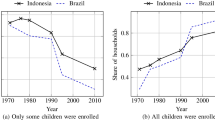Abstract
How does the effect of child mortality reductions on fertility and education vary across educational systems? To answer this question, we develop an overlapping-generations model where altruistic parents care about both the number and human capital of their surviving children. We find that, under a private education system, if income is low initially, the economy converges to a Malthusian stagnation steady state. For a high level of initial income, the economy reaches a growth path in which children’s education rises and fertility decreases with income. In the growth regime under private education, exogenous shocks that lower child mortality are detrimental for growth: fertility increases and education declines. In contrast, under a public education system, the stagnation steady state does not exist, and health improvement shocks are no longer detrimental for growth. We therefore offer a new rationale for the introduction of public education.








Similar content being viewed by others
Notes
We use the data on total fertility rate.
For simplicity, we abstract from physical capital.
Notice, by contrast, that, in the presence of inequality in the distribution of landownership, as in Galor et al. (2009), a reduction in mortality should encourage further landowners to promote policies that deprived the masses from education. The interests of landowners indeed lie in the reduction of the mobility of the rural labor force.
References
Azarnert LV (2006) Child mortality, fertility and human capital accumulation. J Popul Econ 19(2):285–297
Becker GS, Philipson T, Soares RR (2005) The quantity and quality of life and the evolution of world inequality. Am Econ Rev 95(1):277–291
Blackburn K, Cipriani GP (2002) A model of longevity fertility and growth. J Econ Dyn Control 26(2):187–204
Chakraborty S, Papageorgiou C, Sebastian FP (2008) Diseases and development: a theory of infection dynamics and economic behavior. Working Paper
Cigno A (1998) Fertility decisions when infant survival is endogenous. J Popul Econ 11(1):21–28
Cutler D, Deaton A, Lleras-Muney A (2006) The determinants of mortality. J Econ Perspect 20(3):97–120
Dahan M, Tsiddon D (1998) Demographic transition, income distribution, and economic growth. J Econ Growth 3(1):29–52
De la Croix D, Doepke M (2003) Inequality and growth: why differential fertility matters. Am Econ Rev 93(4):1091–1113
De la Croix D, Doepke M (2004) Public versus private education when differential fertility matters. J Dev Econ 73(2):607–629
Doepke M (2005) Child mortality and fertility decline: does the Barro-Becker fit the facts. J Popul Econ 18(2):337–366
Doepke M, Zilibotti F (2005) The macroeconomics of child labour regulation. Am Econ Rev 95(5):1492–1524
Galor O (2005) From stagnation to growth: unified growth theory. In: Aghion P, Durlauf S (eds) The handbook of economic growth, North-Holland, Amsterdam, pp 171–293
Galor O, Moav O (2006) Das human-kapital: a theory of the demise of the class structure. Rev Econ Stud 73(1):85–117
Galor O, Tsiddon D (1997) The distribution of human capital and economic growth. J Econ Growth (1):93–124
Galor O, Weil DN (1999) From malthusian stagnation to modern growth. Am Econ Rev 89(2):150–154
Galor O, Weil DN (2000) Population, technology, and growth: from malthusian stagnation to the demographic transition and beyond. Am Econ Rev 90(4):806–828
Galor O, Zeira J (1993) Income distribution and macroeconomics. Rev Econ Stud 60(1):35–52
Galor O, Moav O, Vollrath D (2009) Inequality in landownership, the emergence of human-capital promoting institutions, and the great divergence. Rev Econ Stud 76(1):143–179
Hazan M, Berdugo B (2002) Child labour, fertility, and economic growth. Econ J 112(482):810–828
Kalemli-Ozcan S (2002) Does the mortality decline promote economic growth? J Econ Growth 7(4):411–439
Kremer M, Chen D (2002) Income distribution dynamics with endogenous fertility. J Econ Growth 7(3):227–258
Livi-Bacci M (2001) A concise history of world population. Blackwell, Oxford
Morand OF (1999) Endogenous fertility, income distribution, and growth. J Econ Growth 4(3):331–349
Shultz T (1993) Mortality decline in the low-income world: causes and consequences. Am Econ Rev 83:337–342
Strulik H (2003) Mortality, the trade-off between child quality and quantity, and demo-economic development. Metroeconomica 54(4):499–520
Strulik H (2004) Child mortality, child labour and economic development. Econ J 114(497):547–568
Tabata K (2003) Inverted u-shaped fertility dynamics, the poverty trap and growth. Econ Lett 81(2):241–248
Acknowledgements
I am very grateful to Matthias Doepke, Oded Galor, Leonid Azarnert, Davide Fiaschi, Simone D’Alessandro, and two anonymous referees for helpful comments and suggestions. I also benefited from discussions with seminar participants at the conference on the institutional and social dynamics of growth and distribution (Lucca, December 2007), the annual conference of the Scottish Economic Society (Perth, April 2007), and the Jerusalem Summer School in economic growth (Jerusalem, July 2008). Any responsibility is mine.
Author information
Authors and Affiliations
Corresponding author
Additional information
Responsible editor: Alessandro Cigno
Appendix
Appendix
1.1 A Optimal conditions with private education
Given agents maximization problem by Eqs. 10, 11, and 12, the first-order conditions yield Eqs. 13 and 14 for the optimal number of children and the optimal education spending, respectively. Substituting Eqs. 13 and 14 into the budget constraint, we obtain the optimal consumption as follows:
from which, consumption is above the subsistence level, i.e., \(\tilde{c},\) if:
where we define the human capital level \(\tilde{h}=\tilde{c}/\left( 1-\gamma \right) \) such that \(c_{t}^{i}=\tilde{c}.\)
When \(c_{t}^{i}>\tilde{c}\), a fraction 1 − γ of \(h_{t}^{i}\) is devoted to the consumption and a fraction γ of \(h_{t}^{i}\) is devoted to children, that is:
where \(n_{t}^{i}=\pi (h_{t}^{i})N_{t}^{i}\) is the number of surviving children.
When \(c_{t}=\tilde{c},\) the difference between income and the subsistence consumption is devoted to children, that is:
Given Eq. 14, there is a corner solution for education if:
where, using Eq. 6, we obtain the following solutions for \( h_{t}^{i}\):
where h 1 > 0 and h 2 < 0.
We define the human capital \(h_{1}=\underline{h}\) such that, when \(h_{t}^{i}< \underline{h}\), the optimal choice for education is zero. Given the human capital level \(\tilde{h}\), it is possible to distinguish two cases depending on if \(\tilde{h}<\underline{h}\) or \(\tilde{h}>\underline{h}\). We assume that is \(\tilde{h}<\underline{h}.\) Hence, when \(\tilde{c} < h_{t}^{i} < \tilde{h},\) the optimal choice for education is zero, that is:
substituting this solution into Eq. 39, the optimal number of children, i.e., \(N_{t}^{i}\), is given by:
When \(h_{t}^{i}=\tilde{h},\) it follows that:
When \(\tilde{h}<h_{t}^{i}\leq \underline{h}\), consumption is above the subsistence level \(c_{t}>\tilde{c}\) and the optimal spending in education is zero. Hence, agents maximize the following utility function:
which yields the following optimal decision rule for the number of children:
When \(h_{t}^{i}>\underline{h}\), the optimal number of children and the optimal choice for education are given by Eqs. 13 and 14, respectively.
1.1.1 A.1 Optimal fertility
The optimal fertility \(N_{t}^{i},\) given by Eq. 17, when \(\tilde{c} < h_{t}^{i} < \tilde{h},\) increases in human capital and has a concave shape with respect to \(h_{t}^{i},\) that is:
and:
When \(h_{t}^{i}>\bar{h}\), the optimal number of children decreases in \( h_{t}^{i},\) that is:
since \(\pi \left( h_{t}^{i}\right) -h_{t}^{i}\pi ^{\prime }\left( h_{t}^{i}\right) >0.\) Now, we proceed to analyze the optimal number of surviving children \(n_{t}^{i}\), that is:
Given Eq. 44, when \(\tilde{c}\leq h_{t}^{i}\leq \underline{h}\), the optimal number of surviving children increases in human capital, that is:
When \(h_{t}^{i} < \underline{h}\), the optimal number of surviving children decreases in \(h_{t}^{i},\) that is:
if:
1.1.2 A.2 Optimal education
Given the optimal education choice in Eq. 16, when \( h_{t}^{i}>\underline{h}\), the spending in education of each child increases in \(h_{t}^{i}\) and has a concave shape with respect to \(h_{t}^{i},\) that is:
since \(\pi (h_{t}^{i})-h_{t}^{i}\pi ^{\prime }(h_{t}^{i})>0.\)
The second derivative is given as follows:
1.2 B Human capital
1.2.1 B.1 Private education
Given human capital accumulation in Eq. 24, the economy shows multiple development paths if:
which is satisfied if:
When \(h_{t}^{i}\leqslant \underline{h},\) the economy shows the stable steady state h L , that is:
where:
When \(h_{t}>\underline{h},\) the economy grows in the long run at a constant rate:
if:
1.2.2 B.2 Public education
1.2.2.1 B.2.1 Relative human capital
We define the dynamic of the relative human capital of a poor agent given by Eq. 35 as:
It increases with respect to \(\hat{h}_{t}^{P}\), that is:
and \(\Psi ^{\prime \prime }(\hat{h}_{t}^{P})<0\) for \(\hat{h}_{t}^{P}\leq 1\) and \(\Psi ^{\prime \prime }(\hat{h}_{t}^{P})>0\) for \(\hat{h}_{t}^{P}>1\), that is (see Fig. 6):
Equation 53 shows two steady states 0 and 1. The steady state 0 is unstable, that is:
and the steady state 1 is stable, that is:
1.2.2.2 B.2.2 Average human capital
The average human capital of children given by Eq. 36 increases with respect to average human capital of parents. In particular, we define \(e(\overline{h}_{t})=\overline{e}_{t}\):
where \(e^{\prime }(\overline{h}_{t})>0,\) that is:
since, from Eq. 6, we have that \(\pi (\overline{h}_{t})/ \overline{h}_{t}\pi ^{\prime }(\overline{h}_{t})>1.\)
Finally, the economy grows in the long run, that is:
if the following condition holds:
Rights and permissions
About this article
Cite this article
Fioroni, T. Child mortality and fertility: public vs private education. J Popul Econ 23, 73–97 (2010). https://doi.org/10.1007/s00148-009-0248-5
Received:
Accepted:
Published:
Issue Date:
DOI: https://doi.org/10.1007/s00148-009-0248-5




